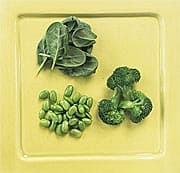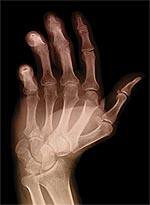Life Extension Magazine®
Lutein and Zeaxanthin Reduce Macular Degeneration Risk | |
Lutein and zeaxanthin protect against age-related macular degeneration,* a condition that occurs when the eye’s macula deteriorates, leading to visual impairment and blindness. Scientists evaluated the diets of 4,519 participants aged 60 years and above. Retinal photographs were used to divide the subjects into five categories of macular disease severity, and dietary questionnaires were analyzed for nutrient intake. Participants whose intake of lutein and zeaxanthin was the greatest had a significantly lower risk of age-related macular degeneration than those whose intake was the least, and were also less likely to have large or numerous intermediate drusen, the deposits on the retina or optic nerve that characterize the disease. “Lutein and zeaxanthin may be considered as useful agents in food or supplement-based interventions designed to reduce the risk of [macular degeneration],” the researchers concluded. —Dayna Dye | |
| Reference | |
| * Age-Related Eye Disease Study Research Group. The relationship of dietary carotenoid and vitamin A, E, and C intake with age-related macular degeneration in a case-control study: AREDS Report No. 22. Arch Ophthalmol. 2007 Sep;125(9):1225-32. | |
High-Dose Folic Acid Improves Endothelial Function | |
Folic acid supplements improve endothelial function in a dose-dependent fashion, according to a recently published meta-analysis.* Endothelial dysfunction is one of the key processes underlying cardiovascular disease. Scientists analyzed data collected from 14 randomized, double-blind, placebo-controlled trials involving a total of 732 subjects. All studies assessed endothelial function by measuring the change in brachial artery flow-mediated dilation after folic acid supplementation, compared with the change following administration of a placebo. Folic acid supplementation improved endothelial function, with higher doses yielding greater benefits. In addition, participants at greater risk of cardiovascular disease tended to have larger improvements. Folic acid’s ability to improve endothelial function may be mediated by its ability to lower homocysteine, a cardiovascular risk factor that impairs arterial health. The authors concluded, “This study indicates that high doses of folic acid improve endothelial function, which could potentially reduce the risk of cardiovascular disease.” —Dayna Dye | |
| Reference | |
| *de Bree A, van Mierlo LA, Draijer R. Folic acid improves vascular reactivity in humans: a meta-analysis of randomized controlled trials. Am J Clin Nutr. 2007 Sep;86(3):610-7. | |
Bone Osteocalcin Regulates Energy Metabolism | |
A new study published in the scientific journal Cell is the first to establish a relationship between the vitamin K-dependent hormone, osteocalcin, and regulation of insulin.* The findings establish the skeleton as an endocrine organ that controls energy metabolism, which has important implications for the treatment of obesity and diabetes. Using genetically altered mice, investigators determined that osteocalcin, a hormone secreted by osteoblasts (a type of bone cell), is capable of stimulating insulin secretion and improving insulin sensitivity. The findings indicate that the skeleton helps regulate energy metabolism in a feedback-loop fashion. “Our results add further credence to the concept that bone and energy metabolisms exert reciprocal regulations,” wrote the authors. “By revealing that the skeleton exerts an endocrine regulation of sugar homeostasis this study expands the biological importance of this organ and our understanding of energy metabolism,” they concluded. —Dale Kiefer | |
| Reference | |
| *Lee NK, Sowa H, Hinoi E, et al. Endocrine regulation of energy metabolism by the skeleton. Cell. 2007 Aug 10;130(3):456-69. | |
Eye Diseases Linked to Increased Mortality Risk | |
| Individuals with visual impairment from eye diseases such as cataracts or age-related macular degeneration appear to have a higher likelihood of premature death compared with similar individuals without these conditions, Australian researchers reported.* Researchers followed over 3,600 participants for an average of 11 years. Participants with any visual impairment, those with cataracts, and those with age-related macular degeneration were all more likely to die during the study period than those without these conditions. It is not clear whether the link between visual impairment and death is a direct one, or if another factor is involved. “The implications of these findings also remain uncertain: whether such an association indicates that visual impairment, age-related eye disease, or both are markers of aging and frailty or whether these ocular conditions accelerate aging, thus leading to relatively earlier death in older persons,” the researchers wrote. —Marc Ellman, MD | |
| Reference | |
| * Cugati S, Cumming RG, Smith W, Burlutsky G, Mitchell P, Wang JJ. Visual impairment, age-related macular degeneration, cataract, and long-term mortality: the Blue Mountains Eye Study. Arch Ophthalmol. 2007 Jul;125(7):917-24. | |
Colorful Anthocyanins Fight Colon Cancer | |
| Anthocyanins—compounds that give red, violet, and blue plants their color—offer powerful colon cancer-fighting ability, according to recent research.* Various extracts containing anthocyanins were tested on cultured human colon cancer cells. Using extracts from grapes, radishes, purple corn, chokeberries, bilberries, purple carrots, elderberries, and other plants, scientists determined the amount needed from each to decrease the growth of the cancer cells by half. Purple corn extract was the most potent, followed by chokeberry and bilberry. Anthocyanins from radish and black carrots slowed the growth of cancer cells anywhere from 50% to 80%; however, anthocyanins from purple corn and chokeberries completely stopped the cancer growth, as well as killing 20% of the cancerous cells. In rats, anthocyanins from bilberries and chokeberries reduced the signs of colon tumors by 70% and 60%, respectively. “All fruits and vegetables that are rich in anthocyanins have compounds that can slow down the growth of colon cancer cells,” the authors concluded. —Dayna Dye | |
| Reference | |
| * Available at: http://www.eurekalert.org/pub_releases/2007-08/osu-ctc081507.php. Accessed August 27, 2007. | |
Calcium, Vitamin D Protect Against Breast Cancer | |
| Women with a higher intake of calcium enjoy a lower risk of developing breast cancer, according to two recent epidemiological studies involving large groups of women.1,2 A protective effect is also correlated with vitamin D intake.1 One study, conducted in France, considered calcium obtained from dairy products. Results showed that women with the highest intake of dairy calcium enjoyed a 45% reduction in breast cancer risk. The risk reduction reached 65% for premenopausal women. “Our data support the hypothesis that dairy products, through calcium content or a correlated component, might have a negative association with the risk of breast cancer, particularly among premenopausal women,” wrote the researchers.2 Similarly, an American study found that premenopausal women with the highest intakes of calcium and vitamin D reduced their risk of developing breast cancer by nearly 40%.1 —Dale Kiefer | |
| Reference | |
| 1. Lin J, Manson JE, Lee IM, Cook NR, Buring JE, Zhang SM. Intakes of calcium and vitamin D and breast cancer risk in women. Arch Intern Med. 2007 May 28;167(10):1050-9. |










